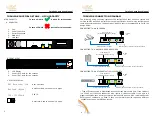
Thrulink Operations Manual
ADVANCED OPERATION (CONTINUED)
c.
Protocol
UDP and TCP are available protocols. UDP is default
and recommended for most connections. TCP is
recommended in a high packet loss environment as it
guarantees packet delivery.
d.
Port Selection
A port must be identified on the Server and matched
on the Client side as well. Ports 8080 through 8087
are available as preset selections, however any port
can be assigned by clicking “OTHER” and then typing
in the desired port.
Preset port chosen:
The note that appears under the port indication
reminds the user to forward the port chosen to the
WAN IP of the server. If the WAN IP address is
different than 192.168.0.10, the note will adjust
accordingly.
When a custom port is selected, the note will change
to reflect the custom port:
17
Thrulink Operations Manual
ADVANCED OPERATION (CONTINUED)
2.
Client Mode
In the picture below, the Client is set to communicate to
its primary Server, whose WAN IP address is 10.0.0.10
on Port 8080. The Host Name does not need to match the
Server Host Name in order to establish the tunnel. A
secondary Server (if one is available) can be used as the
“Failover Server” in the event the connection is lost to the
primary Server. A failover Server will only receive the
information from the Client if the primary Server
connection is lost. Further, the secondary Server must
have throughput availability to accept the traffic
previously handled by the primary Server.
a.
Connecting to a Server at a DNS Host name
If the Server is set to a Dynamic DNS Service, the
Primary Server IP on the Client side can either be the
host name address or the Public IP (if known). In the
screen capture below a Client is attempting to connect
to a Server via the DDNS host address:
The actual host ID, service provider and extension to be determined by your host
ID configuration settings. If the actual IP address is known it can be used in
place of the web address.
18
















